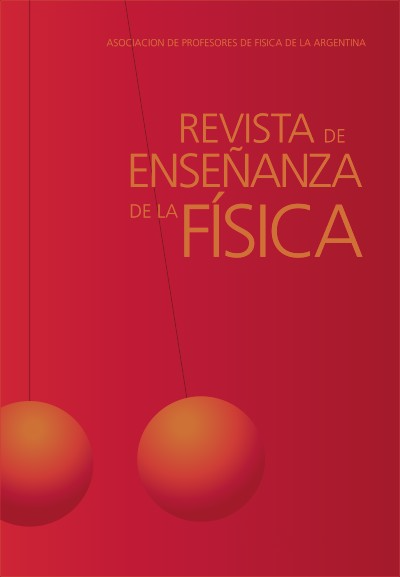Remote experimental class: determination of restitution coefficient using Arduino
DOI:
https://doi.org/10.55767/2451.6007.v34.n1.37937Keywords:
Restitution coefficient, Arduino, Teaching physics, Remote learningAbstract
Among the challenges imposed by the restrictions caused by the covid-19, we can highlight, in particular, the adaptation of experimental activities in the remote mode. This article describes the construction and application of a low-cost experimental prototype, based on the Arduino platform. The prototype was used in a practical class to determine the restitution coefficient in an inelastic collision, between a rubber ball and a wooden surface. The prototype provided real-time data acquisition, in a class with undergraduate physics, enabling the visualization of the phenomenon and data sharing with students. Its operation is based on piezoelectricity, which allowed to graphically observe the proportionality between the kinetic energy in each collision and the intensity of the electrical signal obtained. The experimental results showed low standard deviation and good consistency in several repetitions. They were also compared with other results, obtained by a technique using video, showing an agreement in the order of 2 %.
References
Azevedo, M. C. (2009). Ensino por investigação: Problematizando as atividades em sala de aula. In, A. M. Carvalho (org.), Ensino de Ciências: Unindo a pesquisa e a prática (pp. 19-33). São Paulo: Cengage Learning.
Arnold, F. J., Godeny, A. G., Costa, M. M., Viana, J. F., Ximenes, R. L. (2018). Proposta experimental do estudo de colisões entre bolas de borracha e superfície plana. Revista Brasileira de Ensino de Física, 40(2), e2502.
Carvalho, A. M. P. (2016). O Ensino de Ciências e a proposição de Sequências de Ensino Investigativas. In: A. M. P. Carvalho, Ensino de ciências por investigação: condições para implementação em sala de aula (pp. 01-20). São Paulo: Cengage Learning.
Cavalcante, M. A., Silva, E., Prado, R. (2002). O estudo de colisões através do som. Revista Brasileira de Ensino de Física, 24(2), 150-157.
Fager, M. N. B. et. al., (2021). Objeto de aprendizaje para la enseñanza del electromagnetismo. Revista de enseñanza de la física, 33(extra), 45-53.
Filho, D. P. M., Kamassury, J. K. S., Meira, R. C. S. (2017). Uma discussão sobre o coeficiente de restituição. Revista Brasileira de Ensino de Física, 39(4), e4302.
Gilardi, G., Sharf, I. (2002). Literature survey of contact dynamics modelling. Mechanism and Machine Theory, 37, 1213-1239.
Haron, A., Ismail, K. A. (2012) Coefficient of restitution of sports balls: A normal drop test. IOP Conf. Series: Materials Science and Engineering, 36, 012038.
Montoli, G. A., Neto, J. S. C., (2020). Estudo de Colisões Inelásticas por meio da Videoanálise. Caderno Brasileiro de Ensino de Física, 37(2), 865-878.
Moreira, M. A. (2017). Teorias de aprendizagem. 2. ed. São Paulo: E. P. U.
Rezende, S. M. (2015). Materiais e Dispositivos eletrônicos. 4a ed. São Paulo: Livraria da Física.
Sasseron, L. H. (2009). CTSA no Ensino Fundamental e a argumentação entre alunos e professora. Enseñanza de las Ciencias, V. extra, 28-32.
Wurm, G. E. Ortigoza, L. F., da Silva, R. S., Tworouski, S. P., Chamorro, C. (2021) Banco de termometría controlado por Arduino. El problema de su calibración como experiencia para trabajar el “mito” del punto de ebullición. Revista de enseñanza de la física, 33(extra), 655-663.
Published
How to Cite
Issue
Section
License

This work is licensed under a Creative Commons Attribution-NonCommercial-NoDerivatives 4.0 International License.
Aquellos autores/as que tengan publicaciones con esta revista, aceptan los términos siguientes:Los autores/as conservarán sus derechos de copiar y redistribuir el material, bajo los términos estipulados en la Licencia de reconocimiento, no comercial, sin obras derivadas de Creative Commons que permite a terceros compartir la obra bajo las siguientes condiciones:
- Reconocimiento — Debe reconocer adecuadamente la autoría, proporcionar un enlace a la licencia e indicar si se han realizado cambios. Puede hacerlo de cualquier manera razonable, pero no de una manera que sugiera que tiene el apoyo del licenciador o lo recibe por el uso que hace.
- NoComercial — No puede utilizar el material para una finalidad comercial.
- SinObraDerivada — Si remezcla, transforma o crea a partir del material, no puede difundir el material modificado.
- Los autores/as podrán adoptar otros acuerdos de licencia no exclusiva de distribución de la versión de la obra publicada (p. ej.: depositarla en un archivo telemático institucional o publicarla en un volumen monográfico) siempre que se indique la publicación inicial en esta revista.
- Se permite y recomienda a los autores/as difundir su obra a través de Internet (p. ej.: en archivos telemáticos institucionales o en su página web) antes y durante el proceso de envío, lo cual puede producir intercambios interesantes y aumentar las citas de la obra publicada. (Véase El efecto del acceso abierto).














